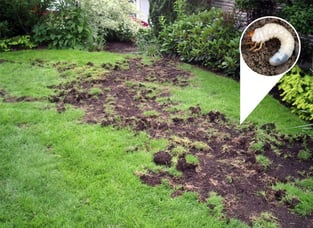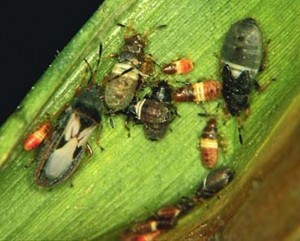There is nothing more disheartening than spending hours and hours watering, weeding, and mowing your lawn only to find that lawn bugs are making your gorgeous lawn their newest feeding ground. Instead of throwing up your hands and walking away, the best way to combat lawn pests is to learn about them! In the following article you will learn about the most common lawn pests that thrive throughout Ontario’s lawns, and how to deal with them.

Hairy Chinch Bugs (July - August)
The adult Hairy Chinch Bug is very hard to spot. At about 4 mm fully grown, it can be identified by the “x” its wings form on its back. To tell if your lawn is home to these little guys, take a metal can and turn it into a cylinder. Then, embed that in the ground and fill it with water. Then, check back later to see if any of these bugs have floated to the surface. The Hairy Chinch attaches itself to individual blades of grass and leaches way plant juice leaving fist sized sunken patches of grass in the first stage, and large dead areas when left untreated. Well irrigated lawns are better equipped to ward off the damage caused by the Hairy Chinch. Although, high levels of endophytic fungi can also reduce chinch bug feeding.

Bluegrass Billbug (July - August)
The Bluegrass Billbug is a member of the weevil family. Adults are black, and approximately 5 mm long. Left untreated the gradually turn small collections of plants yellow. It is rare that bluegrass billbug will affect the health of an entire lawn. If you notice a sawdust like substance on your lawn, then you can be sure a bluegrass billbug is close by.
Sod Webworms (September)
Sod Webworms are small caterpillars that love thatch. They can be identified by their tan colour and dark spots located on their backs. You can confirm the presence of sod webworms just like grubs, by lifting up a small section of sod and searching for their tiny bodies. The best way to reduce sod webworm activity is to keep thatch in check.
Grubs (Late Summer/ Early Fall)
The most common varieties of grubs are: June beetle, European chafer, and the Japanese beetle. Have you ever noticed racoons, skunks, or your pets attempting to dig up irregular patches of brown grass? If so, there might be grubs lurking in the area. To check for grubs, lift a 10 x 10 cm square of sod, and look for white, “C” shaped grubs. To reduce grub population, keep your lawn well irrigated. You may also apply nematodes in the late summer for even better results. Learn more about grubs here.
European Crane Fly (May - June)
The adult European Crane Fly is often mistaken for a large mosquito. Their children however, the larvae are known as leatherjackets. Ranging in size from 0.5 to 3.0 cm in length, leatherjackets are greyish brown larvae with no visible head. They feed on grass shoots during the evening, and the roots during the heat of the day. You will begin to notice the damage they cause during May and continuing into June. While birds will take care of the adults, the larvae are best addressed using a localized insect killer. Always make sure to follow the instructions on the package!
To learn more about lawn pests, or to schedule a complimentary quote, contact us at 613-739-3399, or request a quote online.






